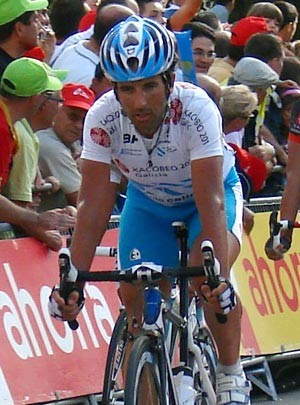UCI moves forwards with disciplinary action
 Almost seven months after the UCI announced that Vuelta a España runner-up Ezequiel Mosquera had tested positive for the substance hydroxyethyl starch, the governing body has requested disciplinary proceedings against the rider.
Almost seven months after the UCI announced that Vuelta a España runner-up Ezequiel Mosquera had tested positive for the substance hydroxyethyl starch, the governing body has requested disciplinary proceedings against the rider.
The Spaniard failed a test taken on September 16th, two days before he won the Bola del Mundo stage and sealed his second place overall behind Vincenzo Nibali. Hydroxyethyl starch is a blood plasma volume expander which can be used to disguise the increase in hematocrit that occurs with the use of EPO and other related substances.
“Following the explanation provided by the rider after adverse analytical findings have been notified to him, the UCI was obliged to conduct further scientific investigations in collaboration with the WADA accredited laboratory of Cologne in order to ascertain the origin of these results,” said the UCI in a statement.
“At the end of this enquiry entrusted to highly qualified experts, and considering all the information currently in its possession, the UCI has concluded that disciplinary proceedings should be opened against Ezequiel Mosquera.”
It said that it was up to the Spanish federation RFEC to determine if the rider had breached anti-doping rules. Depending on what the RFEC decides, the UCI can appeal to the Court of Arbitration for Sport, as it is currently doing in relation to the Alberto Contador case.
Mosquera continues to claim that he has not doped. Last month he issued a ten-point argument against the charges, saying that Hydroxyethyl starch isn’t a doping substance in itself. “That explains why I am not banned and why I am not suspended,” he wrote. “Scientific studies show that Hydroxyethyl starch doesn’t enable the improvement of sporting performance. Hydroxyethyl starch isn’t forbidden in case of intramuscular or oral intake; it is only not authorized by intravenous intake.
“Unlike what is generally assumed, Hydroxyethyl starch doesn’t hide doping substances. This was proved through other cases, where laboratories could detect Hydroxyethyl starch together with EPO.
However his argument doesn’t address the fact that it is not a direct masking agent for EPO, but rather is thought to hide the changes that occur to blood volume and parameters. He did not explain why the substance was in his system.
He issued a press release yesterday evening confirming that the case was moving forward.
“This decision has not changed anything in my personal situation: I am not banned and I am not suspended,” he said, referring to the fact that he hasn’t raced due to a mutual agreement with the Vacansoleil team.
“The case is going before the Spanish Cycling Federation, the only authority who can decide about my current situation. This changed one thing to my current difficult situation which is that from now on I can defend my case.”
He said that he would continue to refuse to give interviews. “This decision is made to have the authorities do their job without external pressure.”
Mosquera’s former Xacobeo Galica team-mate David Garcia also tested positive for the same substance. He subsequently failed a test for EPO. It is believed that the same examination of Mosquera’s samples didn’t show the banned hormone, although its presence is only detectable for a short period of time if micro-dosed. If hydroxyethyl starch is used to mask volume changes with blood transfusions, no EPO will be present.
The RFEC – and, if necessary, CAS – will now examine the case more closely and determine why he had the substance in his body.